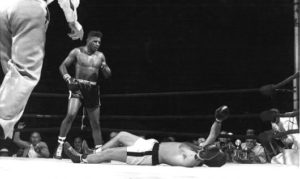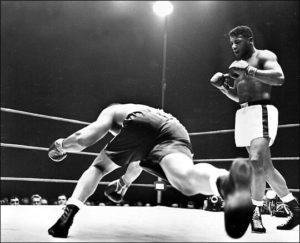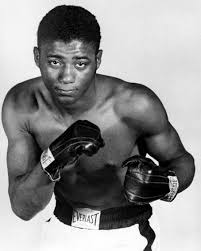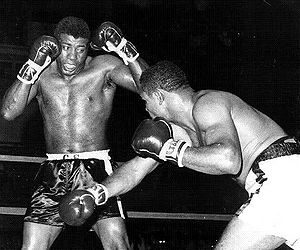The Skills of Floyd Patterson – The First 2 Time HW Champion
Floyd Patterson ignited the heavyweight boxing scene in the 1950’s with his fistic flurries of fury, and leaping left hooks. After being tutored by the legendary boxing philosophy Cus D’Amato from his teenage years, Patterson won an Olympic gold medal in the 1952 games. Patterson then became the youngest heavyweight champion (until Mike Tyson broke the record) at the age of 21, and was the first man to regain the heavyweight title after losing it to Ingemar Johansson. Let’s take a technical look at what skills Floyd displayed, that would later have his name etched into history as a boxing legend.
Peek-a-boo style
The style utilised by Floyd Patterson was taught to him by the legendary boxing philosopher Cus D’Amato, who would later have ‘Iron Mike’ Tyson also adopt the same approach. The fundamentals of the ‘peek-a-boo’ style was aimed at keeping a fighter elusive at all times, by having the head a moving target as much as possible, particularly when a fighter is at his most vulnerable: when he is himself throwing punches.
Head movement
The Peek-a-boo style involved the fighter holding his guard relatively high at the cheek, with the fighter peeking over the gloves. This made it possible to effectively parry opponent’s punches, when head movement was not sufficient enough. This was usually the case when opponent’s tried to throw quick fire punches to catch his head before got to the opposite side, after the initial first slip.
Floyd Patterson’s head movement was his primary method of defence. Patterson’s continuous use of head movement made it extremely difficult to establish a jab against him for some fighters, as to do so would usually be inviting him into counter you off of his head movement. Without an efficient jab, it was an uphill task for a fighter to effectively control distance against Patterson, which was a crucial factor in your success with him.
Counterpunching
The continuous elusiveness of Floyd’s head movement installed uneasiness in Floyd’s opponents. Not because they wasn’t sure of hitting the target, but more so because they were aware that Floyd Patterson loved to counter off of his slips and dips. Patterson was masterful at closing the distance between his opponent, and still remaining a difficult target to hit.
Patterson took his whole body with him when he slipped in one direction. This included bending his legs, sometimes to the point where he was in a leaning crouch-like stance. Patterson would then spring up from his crouch, or squat, transferring momentum up into his punches. Punching from his crouch also made it extremely difficult to track his punches.
Particularly when his opponents threw, and missed, straight punches, they would throw themselves off balance. With their weight flying forward, and their torso leaning in, this would buy time for Patterson to land the counter, until they regained control of their momentum. On many occasions, it would also move right into the punch, increasing it’s impact.
Dropping back into the crouch after throwing the punch kept Patterson elusive, by not leaving his head in the same place. This made it possible to prevent giving his opponent cheap counterpunching opportunities.

Floyd’s left hook decked many opponents
Left Hook
One of the most famous aspects of Patterson’s fight game was his deadly left hook. Combined with Patterson’s speed, it was incredibly difficult to see coming. By the time his opponent’s realised the hook was on it’s way, it was too late. Patterson usually liked to dip down, or slip to the left to set it up, moving him out of the way of any punches. Instinctively, opponent’s would judge the slips as a defensive manoeuvre. Or if it was a dip, then they would instinctively expect a punch to the body.
With his opponent’s mind occupied, this created the window to land the potent left. Floyd would then leap forward, shifting his torso from left to right in order to transfer his momentum into the punch. He would launch forward so powerfully that he would launch himself off the ground, basically leaping at his opponent. Patterson’s approach was certainly risky, but it certainly made for a powerful punch.

Patterson sends Moore to the floor
Unreadable Right
Floyd Patterson had an incredibly effective right hand lead, despite all of the attention that his left hook stole. In fact, because his opponent’s were trying to avoid his left hook so much, that this allowed Floyd Patterson to manoeuvre his opponents directly into his right hand. Patterson would do this by catching his opponent while they move left. If he was drifting to his left too, he would stop, then fire the right hand.
The technique of his right hand was pretty impressive. Patterson shot the right hand straight from it’s starting position, relying on the twist of his torso to generate power, as well as shifting his right foot forward.
Body Punching
As a student of Cus D’Amato, the importance of body punching was ingrained into the style of Patterson. Floyd would target the body, in order to set up openings to the head. As explained by Mike Tyson (in the skills breakdown video), Floyd Patterson’s body punching was aimed at shifting his opponent’s attention downstairs and causing him to drop his guard. With his focus off of his head, this allowed Patterson to land a punch on the head. Seeing as it wasn’t expected, it would usually be effective in damaging in his opponent.
One way in which to shift your opponent’s attention downstairs, is to throw a quick flurry to the body, with not much commitment, and then quickly throw the power punch to the head. The other method that Floyd utilised, was to throw a single shot to the body, and whilst doing so, position his feet so that he could throw an effective punch to the head with full force behind it.
Combination Punching
Much like with his body punching, Floyd was always looking to create an opening for the next punch with all of his combinations. By utilising various angles in each punch with all of his combinations, he would manipulate his opponent’s defence and keep his opponent from being able to easily adapt to his offence.
For example, a favourite of Patterson’s was to throw uppercuts after hooks, and vice versa. Uppercuts bring the opponent’s guard and defensive focus to the centre, creating openings around the side for the hook to exploit. Hooks on the other hand, force the opponent’s guard out to the side, creating openings for the uppercut to take advantage of.
Close Range Fighting
Defence
Patterson’s peek-a-boo style meant that he kept his hands held high at all times. This meant little adjustments were required to defend against incoming punches. This was especially important when Floyd was in close range, when there was less time to react to punches. Even when his opponent landed his punches, Floyd was able to negate the impact by rolling with the punches in the same direction.
Offence
Most fighters are ineffective on the inside due to their inability to generate power on the inside. However, Patterson didn’t need much space on the inside to land hard punches, due to his effective technique. The power that Patterson generated came from his feet and legs. Patterson would plant his feet and bend his knees to allow him to twist his weight into the punch. Patterson would twist his torso into the punch, leaving his arms as the transmitter of all the momentum that he created. Cus D’Amato taught his fighters to punch through the target, rather than at the target. This was evident in the way that Patterson would turn his shoulders into the punch, and was a major factor in allowing him to land powerfully.
Final Note
In all, Patterson’s style was built to live up to the D’Amato belief that a boxer should be exciting and entertaining for the fans. Despite this, it was also important for Patterson to remain elusive and hard to hit. Patterson certainly was the embodiment of the quote ‘hit and not be hit’. In fact, Patterson was great at hitting, not getting hit, then hitting again with the counter.



Leave a Reply
Be the First to Comment!